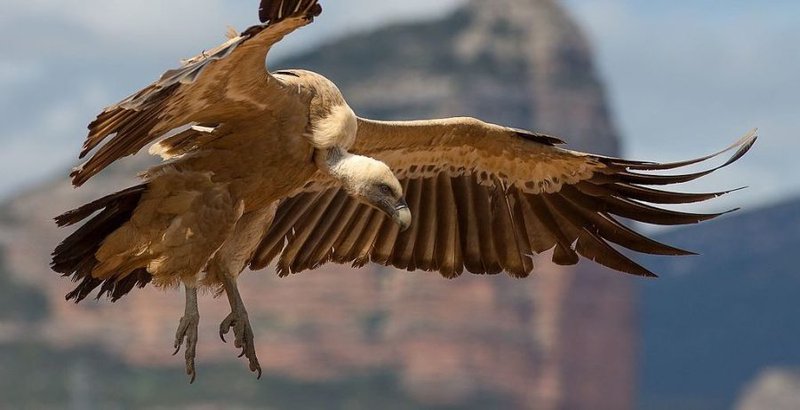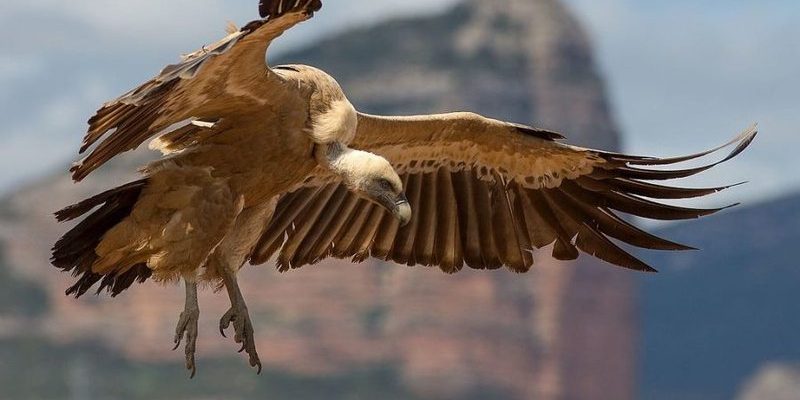
Griffon vultures are more than just big, beautiful birds. They’re a vital part of the food chain, helping to keep our environment healthy. Each fact about them reveals something special, whether it’s about their social behavior or their impressive flying abilities. So, let’s dive in and explore ten amazing facts about the Griffon Vulture that will make you appreciate these creatures even more!
1. Impressive Wingspan
One of the first things you notice about the Griffon Vulture is its wingspan, which can reach up to 10 feet! That’s about as long as a small car is wide. Just picture it gliding effortlessly through the sky, using those enormous wings to catch thermals. This ability allows them to soar for hours without flapping, conserving energy while they search for food.
This impressive wingspan isn’t just for show—it’s crucial for their survival. With such large wings, they can cover vast distances as they search for carcasses. This means they don’t need to be near their food source all the time. Instead, they can fly over mountains and valleys, spotting potential meals from miles away. It’s a perfect example of how nature has equipped these birds for their scavenging lifestyle.
2. Scavengers at Heart
Griffon vultures are true scavengers, meaning they primarily eat dead animals rather than hunting live prey. You might be thinking, “Isn’t that a bit gross?” But here’s the thing: by consuming carrion, they play a vital role in the ecosystem. They help to prevent the spread of disease by cleaning up dead animals that would otherwise rot and potentially spread illness.
When they find a carcass, they often gather in groups, sometimes numbering in the hundreds. This social behavior is fascinating! They communicate with each other, often performing a sort of aerial dance before landing to feast. It’s not just about the food; it’s also a social event for them.
3. Eye for Detail
You might be wondering how these vultures find their food from such high altitudes. It all comes down to their incredible vision. Griffon vultures have excellent eyesight that allows them to spot carrion from several miles away. They can even see colors that humans can’t, which helps them detect the slightest signs of food or movement.
In addition to their keen eyesight, they also rely on other scavengers. If a small bird like a crow or a raven starts circling above, it could be a sign that there’s something to eat below. It’s like having a team of helpers to point them in the right direction!
4. Unique Nesting Habits
Griffon vultures are pretty picky about where they make their homes. They prefer high cliffs or tall trees for nesting, which provide safety from predators. These nests are often made from sticks and lined with softer materials like grass or feathers to keep their eggs cozy.
What’s interesting is that they tend to return to the same nesting site year after year. This attachment is crucial because it helps them maintain a stable breeding territory. Each pair usually raises a single chick at a time, which they care for extensively, teaching it how to live life as a scavenger in the wild.
5. Long Lifespan
Griffon vultures have a surprisingly long lifespan. In the wild, they can live up to 30 years or more! This long life is primarily due to their scavenging diet, which keeps them free from the dangers that predators often face. Plus, their ability to soar high and avoid confrontations helps keep them safe.
In captivity, some Griffon vultures have been known to live even longer, sometimes reaching ages of up to 50 years. That’s like having a lifelong wingman! What’s even more impressive is that they maintain their strong vision and flying skills well into their older years.
6. Importance in Ecosystems
By now, you might realize how essential Griffon vultures are to the environment. Their role as scavengers means they’re nature’s clean-up crew, helping to recycle nutrients back into the ecosystem. Without them, dead animals could pile up, creating health hazards for humans and other wildlife.
Their scavenging habits also support biodiversity. When vultures eat carrion, they help to control populations of other scavengers, ensuring that no single species dominates the food chain. It’s a delicate balance that keeps ecosystems thriving, and Griffon vultures are a crucial part of maintaining that balance.
7. Threats and Conservation
Sadly, Griffon vultures face numerous threats, including habitat loss, poisoning, and hunting. Human activities can disrupt their nesting sites or reduce their food supply. In some areas, they’re even intentionally poisoned because people mistakenly see them as pests.
Conservation efforts are crucial. Many organizations are working to protect their habitats and raise awareness about their importance. By preserving the areas where these vultures thrive, we can help ensure that they continue to soar across our skies for generations to come.
8. Cultural Significance
In different cultures, Griffon vultures are often seen as symbols of life and death. Some ancient civilizations revered them, associating them with spirituality and wisdom. For instance, in Egyptian mythology, the vulture was seen as a protector, often depicted alongside goddesses.
Even today, in various regions, they hold cultural significance. People admire their majestic flight and the role they play in nature. Recognizing these connections can deepen our appreciation for these impressive birds and encourage efforts to protect them.
9. They’re Social Birds
Griffon vultures are definitely social creatures. They often forage and nest in colonies, relying on each other for food and safety. You might see them perched together on rocky cliffs or foraging in fields, often sharing their findings with one another. It’s a bit like a community potluck, where everyone gets to enjoy the meal!
Their social behavior isn’t just limited to eating. They also engage in intricate courtship displays, which can include soaring together and performing aerial acrobatics. These displays help strengthen their pair bonds and ensure that they’re committed partners when it comes time to raise their young.
10. Fascinating Adaptations
Griffon vultures have developed several fascinating adaptations that help them survive. Their bald heads, for instance, might look strange, but there’s a good reason for it. Without feathers on their heads, they can easily clean off any bacteria or debris after feeding. This keeps them healthier and reduces the risk of infections.
Additionally, their powerful digestive system can handle the bacteria often found in decaying flesh. This ability protects them from diseases that might threaten other animals. All these traits together make them incredibly well-suited to their scavenging lifestyle.
In conclusion, the Griffon Vulture may not have the glamorous reputation of some other birds, but their unique characteristics and vital role in nature make them truly remarkable. By understanding and appreciating these incredible creatures, we can do our part to ensure they continue to thrive in the wild. So the next time you spot one soaring high above, remember all the fascinating facts that make these birds such an important part of our world!

